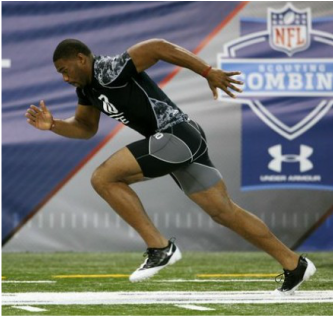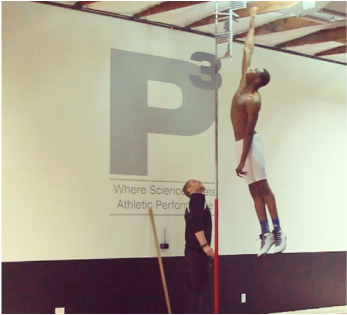|
What does every athletic movement have in common? What do sprinting, grabbing a rebound, shooting a jumper, and blowing by a defender have in common? Triple extension. Quite simply, triple extension is the simultaneous (well, actually sequential, separated by milliseconds) extension or, potentially, locking, of the ankle, knee, and hip joint. If every athlete can maximize each of these extensions, the chain will move much more explosively as a whole, thus placing more force into the ground and propelling the athlete forward or vertically at a higher rate. How Does This Work? When you truly think about it, triple extension is not very complicated biomechanically. If you lock out your joints, your posterior muscles (gluteus, hamstrings, and soleus, particularly) transfer energy more efficiently and powerfully, which makes sense because you are fully contracting your muscles concentrically. Because of the sequential contractions, the distal joints (knee and ankle) can produce more force than if they were isolated. In other words, the joint(s)/muscles above the knee and ankle provide an additional power source, which for example allows the ankle to produce 6 times as much force than in isolation (UMass). Additionally, because your lower-body posterior muscles are some of the most powerful in the body (particularly the gluteus maximus and soleus), it is important to expend as much force from these muscles as possible. Let's take a closer look at how this works in various movements. In sprinting, your hip extends first, providing not only power from the gluteus but balance to take the simultaneous step. Then, the knee locks to expend power from the quadriceps, and finally the ankle plantarflexes to help propel off of the ground with the soleus. Check out the clip below for a graphic. In a vertical jump, triple extension acts in a very similar method, but in the vertical plane. Check out the video below for a graphic. Injury Prevention
In addition to improving performance, the concept of triple extension is very important to the prevention of ankle, knee, and hip injuries in explosive sports, particularly basketball. Primarily, one must ensure that these joints can move efficiently throughout the entire range of motion, or else one cannot fully extend, and if they do, injuries are bound to occur. Thus, ankle and hip mobility exercises are vital (as they are free-moving ball and socket joints), as well as making sure that the surrounding muscles (gastrocnemius, soleus, gluteus, quadriceps, and even hamstrings, hip flexors, and abductors/adductors) are not dangerously tight. Also, when you understand that the hip, knee, and ankle joints work sequentially to perform explosive movements, you can understand why ensuring that each is effective in its movement. Otherwise, the other two joints take a beating, especially the closest proximal joint (above). For example, when the ankles cannot plantarflex effectively, the knees must make up for it, spiking the injury risk for tears and overuse injuries such as tendinitis. How To Train Triple Extension In maximizing one's ability to extend at all three joints, you simply want to focus on movements that are biomechanically similar and mimic the sequential extension. There are two ways to do this (both of which must be implemented into a training program): (1) isolating and strengthening the extension of each joint, and (2) performing exercises that include all three. For example, deadlifts (particularly hex/trap bar deadlifts) primarily strengthen the hips' ability to extend--these are especially important due to the huge amount of strength in the gluteus. However, this is still a compound exercise, meaning that it includes more than one joint. This is something to make sure that most of your exercises involve (squats are another great one) The second part, exercises that extend at the hip, knee, and ankle simultaneously, can be accomplished through strength/explosiveness exercises (explosive step ups with ankle extension, explosive squats to presses, tire flips, kettle bell swings and variations, etc), plyometrics (box jumps, non-countermovement jumps, etc), and olympic lifts (cleans, snatches)--which are more advanced. On all of these, though, focus on extending all three joints powerfully, and it will bring you to your maximum potential. Sources: http://www.umass.edu/locomotion/pdfs/scj-1998.pdf
4 Comments
bller
1/23/2018 01:16:24 am
This post is amazing. Thanks.
Reply
Brendan
2/5/2020 01:47:26 am
Good, simple training advice that emphasises the fundamentals. Also gained a great deal of knowlege from the following training manual. Had some really good information regarding power development for athletes that can be applied across all sports. Let me know what you guys think of it.
Reply
Vinit s kotian
2/29/2020 03:53:17 am
Thanks for the study material, truly nice language and better understanding of the movement. Making it easy to understand and explain it to others.
Reply
4/13/2022 08:53:05 am
What an exquisite article! Your post is very helpful right now. Thank you for sharing this informative one.
Reply
Leave a Reply. |
Coleman AyersFounder/Owner of By Any Means Basketball Categories
All
Archives
September 2020
|
|
By Any Means Basketball is a Miami, Florida-based basketball and athletic performance training organization, centered around using science-based training methods to optimize performance and shift the global basketball culture.
Email: [email protected] Twitter: @byanymeansbball Instagram: @byanymeansbasketball YouTube: By Any Means Basketball Privacy Policy |



 RSS Feed
RSS Feed
